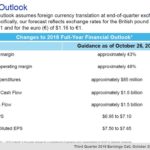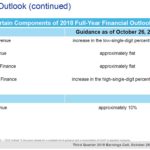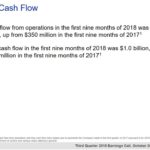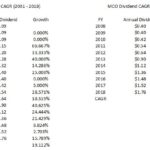Contents
Summary
- Moody’s (MCO) and S&P Global Inc. (SPGI) command a ~80% market share of the ratings industry.
- I view these two companies much like I view the VISA and Mastercard oligopoly.
- MCO released less than stellar Q3 results on October 26th. Its share price has been taking a beating subsequent to the last week of July with a dramatic pullback evidenced starting mid-September.
- Berkshire Hathaway has held a position in MCO since it went public in 2000 and has increased its holdings over time. As at June 30, 2018 it held in excess of 24.6 million MCO shares.
- The time to invest in high quality companies such as MCO and SPGI is when business conditions are challenging.
Introduction
The reasonably broad pullback we are currently witnessing is, in my humble opinion, long overdue. I honestly have no idea when it will end but I am viewing the pullback like an early Christmas gift.
This brings us to the topic of this article - Moody’s Corporation (NYSE: MCO).
I can totally appreciate why the investment community has hammered MCO’s stock price and in particular on October 26th when it released its Q3 results. Its results were less than stellar!
Investors with a long-term investment time horizon, however, will keep in mind that MCO has a strong market position and benefits from its diverse operations and strategic acquisitions.
Elevated expense levels and weakness in global bond issuances will pose a challenge in the short-term but MCO has announced measures being taken immediately to bring costs under control. Since MCO expects continued lighter debt issuance in Q4, it is undertaking cost management activities which will result in a Q4 restructuring charge of $30 - $40 million and an aggregate charge of $45 - $60 million through the first half of 2019. These cost management activities are expected to result in incremental annualized savings of $30 - $40 million.
When I analyzed MCO in my March 3rd article I indicated that its share price was a bit rich for my liking and placed it on my ‘watch list’.
Now that MCO’s share price has taken a pounding I acquired 250 shares for the FFJ Portfolio on October 26th.
I did the exact same thing when I analyzed S&P Global Inc. (NYSE: SPGI) in my March 4th article.
SPGI’s shares have taken a recent pounding and I have just acquired 200 shares for the FFJ Portfolio.
I view the SPGI and MCO oligopoly much like I view the Visa and Mastercard oligopoly. Both companies provide ratings services and more and together command a ~80% market share; Fitch is a distant 3rd with a ~15% market share.
When I read financial statements, the ratings agencies most often mentioned are MCO and SPGI. Quite often companies have conditions of credit in which the minimum permissible rating assigned by one of these two companies must be satisfied otherwise the terms and conditions of the credit facilities become more onerous. In essence, the services provided by MCO and SPGI are critical in the business world.
Berkshire Hathaway initiated a position in MCO in 2000 when Dun & Bradstreet split into 2 companies and took MCO public. I view this and the fact Berkshire Hathaway has increased its exposure over the years as a huge vote of confidence.
Quite frankly, the fact I have never previously had exposure to these two companies is somewhat mind boggling.
Q3 2018 Financial Results
MCO’s October 26, 2018 Earnings Release can be found here. You are also strongly encouraged to review MCO’s Q3 2018 Earnings Presentation.
MCO experienced a similar challenge as SPGI in Q3. Weak global bond issuance volume hurt its results and also adversely impacted performance of the Moody’s Investors Service (MIS) segment. Stable expenses and reasonable Moody’s Analytics (MA) segment performance helped offset the challenges experienced by the Investors Service segment.
MIS revenue decreased 7% YoY due to lower U.S. and international revenues; FX translation had a negligible impact on revenue.Corporate finance revenues declined as a result of a drop in U.S. investment grade and global high yield bond issuance activity. Structured finance revenues also dropped. This was primarily due to lower U.S. CMBS rated issuance with only a partially offset by contribution from collateralized loan obligations.
MCO also recorded a decrease in global public, project and infrastructure finance revenues due to a decline in global infrastructure and project finance issuance.
Financial institutions related revenues improved, however, primarily reflecting growth in issuance activity from M&A-related financing in the U.S. insurance sector.
MA revenues increased 18% YoY. This was driven by higher U.S. and international revenues with FX translation unfavorably impacting this segment’s revenues by 1%.
This segment recorded growth in research, data and analytics revenues and professional services revenues. Enterprise Risk Solutions revenues were stable.
On December 31, 2017, MCO had $5.5B of outstanding debt and $0.870B of additional borrowing capacity under its revolving credit facility. MCO now reports $5B of outstanding debt and $0.975B of additional borrowing capacity under its revolving credit facility.
As of Sep 30, 2018, MCO had total cash, cash equivalents and short-term investments of $1.15B which is ~3% less than as at FYE2017 (December 31).
FY2018 Outlook
In its July 27th Q2 Earnings Release, MCO reaffirmed its full year 2018 diluted EPS guidance of $7.20 - $7.40 and adjusted diluted EPS guidance of $7.65 - $7.85.
Fast forward to the release of the Q3 results on October 26th and full year guidance has been revised downward to reflect diluted EPS guidance of $6.95 - $7.10 and adjusted diluted EPS guidance of $7.50 - $7.65.
Source: MCO’s Q3 2018 Earnings Presentation
Valuation
Following the release of Q2 results on July 27th, MCO closed at $176.60. Using the guidance provided at the time, MCO’s forward PE based on diluted EPS was expected to be in the range of ~23.86 - ~25.53 and ~22.5 - ~23.08 based on forward adjusted diluted EPS.
With MCO exchanging hands at $141.63 as at the close of business on October 26th, MCO’s forward PE based on revised diluted EPS is expected to be in the range of ~19.95 - ~20.38 and ~18.5 - ~18.88 based on revised forward adjusted diluted EPS.
Using the updated diluted EPS range reflected above we now see that MCO’s current valuation is more favorable than the 2013 – 2017 PE levels of 23.2, 21.7, 21.5, 20.3 and 52.1. Prior to that 5 year timeframe, MCO’s PE levels in 2008 – 2012 were 10.7, 15.8, 12.3, 12.7, and 16.5. Those extremely low 2008 – 2012 valuations were the fallout from The Financial Crisis and I would not expect MCO’s PE to approach those levels in the current environment.
Credit Ratings
MCO’s credit ratings assigned by SPGI and Fitch continue to be BBB+; this is a lower medium grade credit rating.
Free Cash Flow (FCF)
FCF for the first 3 quarters of FY2018 is as follows.
Source: MCO’s Q3 2018 Earnings Presentation
Cash flow from operations in 2017 was $0.7475B versus $1.3B in 2016. FCF amounted to $0.6569B versus $1.1B in 2016. These declines were due to the $0.864B Settlement Charge payment in 2017.
FCF in 2014, 2015, and 2016 amounted to $0.944B, $1.1B, and $1.1B respectively.
I view MCO’s current FCF as acceptable.
Dividend, Dividend Yield, and Dividend Payout Ratio
MCO’s dividend history can be found here.
MCO’s annual dividend growth subsequent to 2001 has been inconsistent as evidenced by the following two charts. The compound annual growth rate over the two timeframes analyzed, however, has been respectable.
With MCO having closed at $141.63 on October 26th, the current $0.44/quarter dividend ($1.76 annually) provides investors with a ~1.24% dividend yield. I fully expect investors who place a high priority on dividend income will pass on MCO…much like they will also pass on SPGI.
The current $1.76 annual dividend is a ~24.8% - ~25.3% payout ratio on the basis of projected diluted EPS of $6.95 - $7.10. This payout ratio range is lower than that during the 2015 – 2017 timeframe. I see no issue in MCO being able to service its dividend.
I certainly do not envision MCO announcing in early December a double digit percentage increase in its quarterly dividend. I think investors should temper their expectations and expect a 3% - 5% increase and this is the range I have used in my decision to invest in MCO.
The weighted average number shares outstanding for the 9 months ending September 30th amounted to 191.7 million and 194.4 million on a diluted basis.
The diluted weighted average number of shares outstanding in FY2017 was 194.2 million versus 195.4 million in FY2016. This compares very favorably with the 291.9 million diluted weighted average number of shares outstanding in FY2006.
The downward trend in the diluted weighted average number of shares outstanding is encouraging.
Final Thoughts
I completely recognize that MCO is experiencing some challenging business conditions. This has resulted in the investment community knocking ~25% from MCO’s 52 week high share price. That, quite frankly, is perfectly fine with me.
I view the SPGI and MCO oligopoly much like I view the Visa and Mastercard oligopoly. They are industry leaders which provide critical services to the business and investment communities.
Business is certainly cyclical and the time to invest in these companies is when investor sentiment in general is taking a hit.
I can totally appreciate how dividend focused investors will shy away from this low dividend yielding stock. If, however, the need for dividend income is not a top priority, you have a long-term investment time horizon, and you are prepared to weather market turbulence then MCO might be a suitable component of your investment portfolio.
I wish you much success on your journey to financial freedom.
Thanks for reading!
Note: I sincerely appreciate the time you took to read this article. Please send any feedback, corrections, or questions to [email protected].
Disclaimer: I have no knowledge of your individual circumstances and am not providing individualized advice or recommendations. I encourage you not to make any investment decision without conducting your own research and due diligence. You should also consult your financial advisor about your specific situation.
Disclosure: I am long MCO and SPGI.
I wrote this article myself and it expresses my own opinions. I am not receiving compensation for it and have no business relationship with any company whose stock is mentioned in this article.






